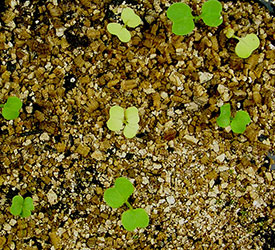University of Wisconsin-Madison
Website
FPsc is a highly inbred analogue of the self-incompatible Wisconsin Fast Plants™ (WFP) variety of rapid-cycling Brassica rapa. Whereas both varieties share several useful properties that commend their use in K-16 classroom—rapid generation time, vigorous growth with minimal material inputs, and tractable phenotypic traits—the capacity of FPsc to propagate via self-pollination and its essentially homozygous genome afforded us unique opportunities to develop and exploit a robust suite of resources that permit an integrated approach to Mendelian and molecular genetic analyses. Thus, we have generated a diverse collection of FPsc mutant derivatives whose phenotypes are unambiguously distinct from the wild type (wt) reference strain and whose alleles transmit from parental to progeny generations according to fundamental Mendelian genetic principles. Concurrently, we have developed a collection of polymorphic molecular markers that span the B. rapa genome, enabling students to localize causative mutant loci by using rapid and robust PCR assays. Finally, working with the Joint Genome Institute, we have produced a de novo whole genome sequence (WGS) assembly that allows students to evaluate gene structure and function as might relate to the mutant phenotypes they observe, thus connecting evident plant phenotypes to underlying, DNA sequence-based genotypes.
We are working in the context of the Cold Spring Harbor Laboratory RNA-Seq Working Group to develop additional FPsc genomic resources that will afford students to move beyond identification of causative mutant loci and to gain a deeper understanding of the functional consequences of mutations. That is, while it may be useful to know that a loss-of-function mutation at gene x yields a particular phenotype when in homozygous condition, the downstream consequences of that missing function are of obvious interest: absent that activity, what other changes in gene expression ensue to yield the phenotype that students observe? To help students to answer that question we have generated an RNA-Seq data set using RNAs extracted from an FPsc mutant that, due to a mutation that inactivates the locus encoding the evolutionarily conserved ent-kaurene oxidase, is unable to synthesize the plant growth hormone gibberellic acid (GA) and thus germinates to form seedlings that show a classical dwarf mutant phenotype. Remarkably, the dwarf mutant phenotype can be “rescued” by periodic application of aqueous GA solution by students. A time-lapse video of GA-mediated rescue can be viewed at YouTube and illustrates that signs of rescue are apparent at 24 hours after initial GA application.
Thus, our RNA-Seq data set characterizes global changes in B. rapa gene expression in dwarf mutants that are conditioned by exposure to GA. Preliminary analysis indicates that expression of >500 B. rapa transcripts is significantly altered (>2x up or down) within a 24 hour interval. Genes that are differentially expressed will be subjected to validation assays by students at UW-Madison and hopefully elsewhere; lesson plans for implementation of the RNA-Seq experiments themselves, as well as follow-on experiments optimized for use with FPsc genetic stocks, will be developed and made freely available for use by other educators interested to introduce “next-gen” sequencing technologies in their biology curriculum.
FPsc ga-deficient1-2 (gad1-2) mutant populations were grown for 18 DAP and then treated (or not) with 10 ul of 100 uM aqueous GA3 solution delivered by micropipette to the shoot apex. Total RNAs were extracted from all above-ground tissues of 8 seedlings in each gad1-2 treatment group (two biological replicates each of control and +GA samples) after 24 hours. Illumina library preparation and sequencing was performed at Cold Spring Harbor Laboratory. Data analyses were conducted via the Green Line of DNA Subway, developed at Cold Spring Harbor Laboratory.
FPsc gad1-2 RNA-Seq data sets will be made available on the NCBI Short Read Archive at a time to be determined.
Beyond RT-PCR validation assays of differential expression, the function and spatial expression patterns of B. rapa genes identified through RNA-Seq analyses can be examined by using the corresponding Arabidopsis knockout mutants and transgenic reporter constructs. As data obtained from such “proof-of-principle” experiments become available we will update this web site accordingly.
Initial implementation of the FPsc RNA-Seq data-set in a classroom setting is slated for December, 2014 as a capstone project for students enrolled in the UW-Madison course Hort 550: Plant Functional Genomics. The laboratory section of Hort 550 introduces students to the many powerful tools of bioinformatics that may aid us in understanding gene structure and function through analysis of genes identified in the model plant Arabidopsis. The B. rapa RNA-Seq capstone module will challenge students to apply those tools towards analysis and characterization of genes whose expression is affected by exposure to the plant hormone GA.
FPsc gad1-2 F2 seed stocks, in which the recessive dwarf mutant allele is segregating are available upon email request to  and curriculum implementation documents drafted after that experience will be made available here.
and curriculum implementation documents drafted after that experience will be made available here.

